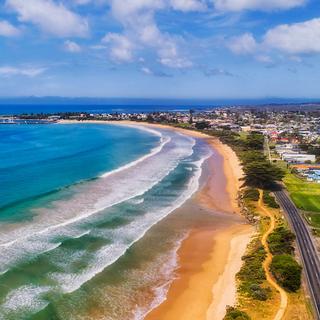
Torquay weather and climate

Torquay weather and climate
Day
14 °C
Night
6 °C
Sea
13 °C
Precipitation
57 mm
in month
Rainy days
13 days
in month
Daylight
10 hours
average
Sunshine
4 hours
average
Humidity
74 %
Weather charts for Torquay

Find more destinations like this
Destinations with similar weather to Torquay
Other destinations in Victoria - Australia
Closest cities for Torquay
Weather overview for Torquay
Weather overview
Torquay, Australia, famed for its temperate and inviting climate, boasts a wide range of temperature fluctuations across the year. Daytime temperatures can vary from a cool average of 14 °C (57 °F) in the depths of July to a warm average of 24 °C (76 °F) during the peak of February. February is also the driest month with only 5 days of rainfall, contrasting with the wettest month of August, which averages 13 days of precipitation. As the sun sets, the nighttime temperatures moderate from a crisp 6 °C (43 °F) in July to a more comfortable 14 °C (58 °F) in February. The region's seas reflect this climate variety, with temperatures ranging from a low of 13 °C (55 °F) in the chilly waters of August to a balmy 19 °C (66 °F) in February.
January weather
In January, as Torquay welcomes the gradual increase in daytime temperatures reaching 24 °C (75 °F), the sea also warms to 18 °C (64 °F). The trend of diminishing rainfall continues with only 6 days of rain expected. As tourism begins to pick up, the number of cloudless hours peaks, and the nighttime temperature sees a rise, noted at 14 °C (57 °F).
February weather
February in Torquay is synonymous with bustling tourist activity, as it marks the zenith of both sea warmth, at 19 °C (66 °F), and daytime heat, peaking at 24 °C (76 °F). Rainfall reaches its lowest point this month, registering at only 5 days, and rainfall volume is likewise minimal at 33 mm (1.31 in). The pinnacle of nighttime warmth is also observed in February.
March weather
Engaging in Torquay's tourist season, one could also note the prolonged dry spell. While the day temperature begins to subtly decrease, a similar decline is noticeable in nighttime temperatures, now at 13 °C (56 °F). With incremental resurgence in wet days, the decrease in sunlight hours to 7 hours is also apparent.
April weather
During April, a downward trajectory in Torquay's day temperatures is matched with a decline in sea temperature, now at 17 °C (63 °F). The increment in wet days to 8 days is juxtaposed with an onset rise in rainfall, measured at 43 mm (1.71 in). Concomitant drops in both nighttime temperature, to 11 °C (52 °F), and hours of sunlight, to 5 hours, are observed.
May weather
May in Torquay continues to bring cooler sea temperatures and a further reduction in daytime warmth, now averaging 17 °C (62 °F). Increased precipitation amounts to 48 mm (1.91 in), and there is a continued ascent in rainy days reaching 10 days. Nighttime temperatures persist in their declination, now averaging 9 °C (48 °F). Furthermore, the gentlest wind speeds of the year, averaging 5, are noted.
June weather
June sees further decline in Torquay's daytime temperatures, down to 14 °C (57 °F), and sea temperatures echo this trend. The night becomes even chillier at 7 °C (45 °F). The rise in rainy days continues, now averaging 12 days. A peak in humidity is also noticeable at 76 %, and the fewest hours of clear skies are recorded.
July weather
July marks the point at which Torquay experiences its lowest daytime temperatures, averaging 14 °C (57 °F), and the sea temperatures likewise continue their descent. The nocturnal temperatures hit their nadir at 6 °C (43 °F), and there's a slight increase in sunny hours, now at 4 hours.
August weather
August signals a moderate rise in daytime temperatures, now at 15 °C (59 °F) in Torquay, while sea temperatures hit their yearly minimum at 13 °C (55 °F). The apogee in rainy days is also noticeable, with their frequency at 13 days. A gradual increase in sunlight hours to 5 hours, and the beginning of night warming is recorded at 7 °C (44 °F).
September weather
September's prominent feature in Torquay is the maximum rainfall volume at 59 mm (2.33 in). The upward trajectory of daytime temperatures is apparent at 16 °C (61 °F), and night temperatures continue their ascent, now at 8 °C (46 °F). An increase in daylight hours is also appreciated.
October weather
The rise in Torquay's sea temperature begins anew in October, noted at 14 °C (57 °F), while day temperatures keep their ascending pattern. The reduction in rainy days is in progress, counted at 10 days, and continuous improvement in sunlight hours is observed with the lengthening days.
November weather
With the arrival of November, there is a noticeable uplift in both day, at 20 °C (68 °F), and sea temperatures, now at 15 °C (59 °F). The downtrend in rainy days maintains momentum, tabulated at 9 days, while a swifter increase in hours of sunlight reflects longer days.
December weather
December in Torquay showcases a continuing elevation in sea temperatures, now at 17 °C (62 °F), with day temperatures matching this rise. A further drop in rainy days is joined by an upswing in unobstructed sun hours, reflecting the extended daylight periods.
FAQs
Are the conditions favorable for a January visit to Torquay?
January stands as an ideal time to visit Torquay, with scant rainfall expected at just 6 days monthly, reducing the need to carry an umbrella. The daytime temperature hovers at a pleasant 24 °C (75 °F) for many but might leave some feeling mildly cool. The sea's chill at 18 °C (64 °F) could be invigorating for some swimmers, whereas others may find it less to their liking. Nighttime temperatures are comfortably cool at 14 °C (57 °F), suggesting indoor dining or adequate layering for outdoor experiences.
How does the sea temperature in Torquay feel during February?
February's sea temperature in Torquay is invitingly warm at 19 °C (66 °F), offering a more agreeable experience for those eager to take a dip. The comfort level for swimming is subjectively warmer, although prolonged immersion might not be everyone's preference.
Does March signal the start of the wet season in Torquay?
Contrary to what one might think, March does not fall within Torquay's wet season—expect to see about 6 days of rainfall over the course of the month.
How often does it rain in Torquay throughout April?
April in Torquay experiences rain on an approximate 8 days. Statistically, this translates to about 1.9 days per week, or roughly 27 % of the days in the month.
What shifts are seen in Torquay's weather during May?
May in Torquay ushers in a more pronounced dip in ocean warmth, now at 16 °C (60 °F). Meanwhile, rain frequents the area on approximately 10 days, adding to a growing pile of 48 mm (1.91 in) of precipitation. The evening chill sets in, now at 9 °C (48 °F), with minimal wind complicating outdoor activities.
How do the sea conditions evolve in Torquay come June?
Torquay's coastal waters cool further in June to an average of 14 °C (57 °F), while dampness is a constant companion with an upswing in rainy days to 12 days, amid rising humidity levels and limited sun exposure.
What defines Torquay's climate during the heart of winter in July?
July in Torquay presents the year's coldest days, averaging around 14 °C (57 °F), while sea temperatures drop to an average of 13 °C (55 °F). Nighttime temperatures reach their lowest at 6 °C (43 °F), but with a slight uptick in hours of sunshine, the brief wintertime reprieve is visible.
Does Torquay enter its rainiest phase in August?
August in Torquay is indeed the peak of its rainfall, with the maximum number of rain days reaching 13 days, alongside a noticeable climb in daytime temperatures and a slow rise in nighttime temperatures.
How much precipitation can be expected in Torquay during September?
As Torquay transitions into spring, a significant quantity of rain falls, peaking at 59 mm (2.33 in), with day temperatures warming to a comfortable 16 °C (61 °F), and evenings becoming less brisk at 8 °C (46 °F).
What weather changes occur as Torquay heads into October?
October in Torquay witnesses a gradual increase in sea temperatures to 14 °C (57 °F) and fewer rainy days, numbering 10 days, as the region benefits from more consistent sunny intervals and lengthier daylight duration.
How does the nocturnal temperature trend in Torquay during November?
Nighttime in Torquay during November offers a temperate average of 11 °C (51 °F), with the early dawn conducive to brisk jogs and evenings suitable for enjoyable al fresco dining, although packing a light sweater may be prudent.
What characterizes daytime temperatures in December in Torquay?
December daytime temperatures in Torquay are delightfully moderate at 22 °C (71 °F), striking an optimal balance for a host of activities, from lounging by the shore to exploring the locale in comfortably light attire.







